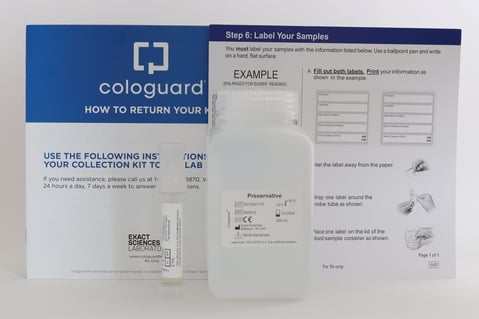Answering Patient Questions About At-Home Colon Cancer Test Options
6 min read

Colorectal cancer is on the decline, but diagnoses at younger ages have been rising since the 1990s.
Colonoscopies continue to be the gold standard in colorectal cancer screening. However, at-home colon cancer tests can be an alternative starting point for people at average risk of developing colorectal cancer.
“At-home colorectal screening tests can get patients started if they are skeptical about doing the prep for colonoscopy or they’re not ready to start the colonoscopy procedure yet,” said Dr. Sujatha Nallapareddy, board-certified medical oncologist and hematologist at Rocky Mountain Cancer Centers (RMCC). “If it’s positive, it reassures the patient that the next step would be to proceed with the colonoscopy. It gives us a starting point, and it also reassures the physician. If it’s negative, maybe patients can wait a little bit longer and keep doing yearly at-home tests and can be monitored closely for screening for colon cancer.”
Your patients can make better decisions about screening when they understand at-home testing options, colorectal cancer risk factors, and the changing demographics of colorectal cancer diagnoses.
Screening Recommendations for Average-Risk Versus High-Risk Patients
Colorectal cancer was once thought of as a cancer primarily affecting older adults. However, the rates of colorectal cancer are declining in people over age 50 and rising significantly among people in their 30s and 40s. If this trend continues, it’s estimated that between 1975 and 2030, the rate of colon cancer will increase by 90% among 20- to 34-year-olds and 27.7% among 35- to 49-year-olds.
In response to the changing demographics of colorectal cancer, the US Preventive Services Task Force now recommends colorectal cancer screening start at age 45 for people with an average risk of colorectal cancer and no symptoms.
After the initial testing, patients should expect to be screened for colorectal cancer regularly through age 75. The screening schedule varies based on the type of test or tests used.
People at high risk for colorectal cancer may need to be screened earlier or more often, including those who have:
- A family or personal history of colorectal cancer or polyps
- A genetic syndrome that has been linked to colorectal cancer, such as familial adenomatous polyposis or Lynch syndrome
- Inflammatory bowel disease
Physicians should also consider ordering a colorectal cancer screening for adults of any age who have possible symptoms of colon cancer, such as:
- Abdominal cramping or pain
- Anemia
- Fatigue
- Feeling as if you still need to have a bowel movement after just having one
- Persistent diarrhea, constipation, or narrow stool
- Rectal bleeding
- Unintentional weight loss
- Weakness
Pros and Cons of At-Home Colon Cancer Screening Tests
At-home colon cancer tests may be particularly well suited for adults under 50 with risk factors for colorectal cancer, patients who are reluctant to have a colonoscopy, or those who can’t receive a colonoscopy due to other medical conditions. These at-home tests have several benefits, including:
- Convenience
- Less stigma than a colonoscopy
- No anesthesia involved
- No colon prep needed
- Noninvasive
However, some patients may be poor candidates for at-home testing, as these tests:
- Have a higher possibility of false positives or false negatives compared with colonoscopy
- May require follow-up testing
- Pose difficulty for patients who are unable to comprehend or follow all steps necessary to perform the test accurately
In addition, an at-home test option, the guaiac-based fecal occult blood test (gFOBT) requires dietary changes for up to a week before it can be used.
Types of At-Home Colon Cancer Tests
There are three main types of at-home colorectal cancer tests:
- Fecal immunochemical test (FIT). This test is used to detect blood in the stool. Changes in diet are not required before testing for the FIT, and stool sample collection is relatively straightforward. Tests need to be repeated annually. The FIT primarily looks for blood from the lower intestine and may not be as sensitive to upper gastrointestinal bleeding.
- gFOBT. The gFOBT also looks for blood in the stool. Multiple gFOBT tests are available. Highly sensitive versions of this test should be chosen for colorectal screenings. Testing should be repeated annually. This test is more sensitive to bleeding in the upper gastrointestinal tract than the FIT. However, the testing procedure may be a barrier for some patients. Stool samples from three bowel movements are required. For accurate results, patients must also avoid citrus fruit and juices, as well as vitamin C supplements for three to seven days before testing, nonsteroidal anti-inflammatory drugs for seven days before testing; and red meats for three days before testing.
 FIT-DNA Test (Stool DNA test). This test detects blood in the stool and cells with abnormal DNA that shed from colorectal cancer or an adenoma. Cologuard is the only approved test of this kind in the United States. This test collects a full stool sample and does not require dietary changes. A stool DNA test should be repeated every three years.
FIT-DNA Test (Stool DNA test). This test detects blood in the stool and cells with abnormal DNA that shed from colorectal cancer or an adenoma. Cologuard is the only approved test of this kind in the United States. This test collects a full stool sample and does not require dietary changes. A stool DNA test should be repeated every three years.
A colonoscopy should follow a positive result on any at-home colorectal cancer screening test to confirm the diagnosis and gather more information.
Sensitivity of At-Home Colorectal Cancer Screenings
FIT, gFOBT, and stool DNA tests can all effectively identify colorectal cancer but have various sensitivity levels.
The sensitivity of the FIT can vary based on the location of the cancer or polyp. It has been shown to detect approximately 74% to 80% of colorectal cancers and 24% of advanced precancerous lesions.
The sensitivity of gFOBT can vary depending on the test used and the type of cancer involved. In studies, the sensitivity of gFOBT to detect colorectal cancers has ranged from approximately 13% to 79%. However, it can still be a helpful tool that can decrease the mortality risk due to colorectal cancer.
Cologuard is the most sensitive at-home test available. It has been shown to detect approximately 92% of colorectal cancers and 42% of advanced precancerous lesions.
Comparatively, colonoscopies remain the ideal screening method for detecting and preventing colorectal cancer. Colonoscopies have a 95% sensitivity for detecting colorectal cancers. Unlike the at-home testing options, colonoscopies allow providers to more readily identify and remove polyps and other precancerous lesions in their early stages with a 75% to 93% sensitivity for detecting polyps under 6 millimeters.
Early detection of colorectal cancers by any means increases the likelihood of successful treatment.
The Role of Family History
Family history is a significant risk factor for developing colorectal cancer and other cancers. Because of this, all providers must obtain a thorough family and personal medical history for every patient. Colorectal cancer may not have any symptoms at the early stages. A family history of colorectal cancer may be the first clue that your patient needs to be screened for colorectal cancer early or more often.
Sometimes, there are barriers to collecting or reviewing family histories, such as a busy clinic schedule or the need for a medical translator for patients who primarily speak a different language. In that case, steps must be taken to overcome those barriers. Furthermore, family histories are living documents and must be updated regularly to ensure you have the information needed to guide clinical decisions related to screening.
The Cost of Screening
Insurance coverage can be a significant factor for many patients. Currently, coverage for colorectal cancer screening typically begins at age 50. Coverage for different types of colorectal cancer screenings or a colonoscopy after a positive at-home screening can also vary depending on insurance coverage. However, beginning in January 2023, provider-recommended at-home colorectal cancer screenings and colonoscopies for average-risk patients will be covered for people aged 45 with private insurance, Medicaid, and Medicare plans. Private insurance providers and Medicaid and Medicare expansion plans will also be required to cover the total cost of a colonoscopy following a positive result on an at-home colon cancer test.
The Next Steps After At-Home Screening
Patients will need to continue with recommended screenings if they:
- Receive a negative test result
- Do not have symptoms of colorectal cancer
- Are at low risk for colorectal cancer
Symptomatic or asymptomatic patients who receive a positive test and patients who have symptoms of colorectal cancer paired with a negative test should be referred to a gastroenterologist for a colonoscopy to confirm the diagnoses or determine which other conditions may be causing symptoms.
“Patients can have false positives and false negatives with at-home test results,” Dr. Nallapareddy said. “We need to interpret them very carefully in those contexts. If your patient has a positive test, then they need to make sure they follow up with a colonoscopy.
Rocky Mountain Cancer Centers provides innovative, holistic treatment options for people with colorectal cancer. Refer a patient today.